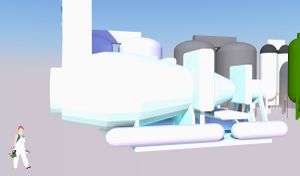Difference between revisions of "Compression"
(Created page with "Adiabatic compression '''Compression power equation''' When the compression is small, we can get away with the following simple equation: 1) W=(Q*dp)/n Where: W= compress...") |
|||
| (9 intermediate revisions by the same user not shown) | |||
| Line 1: | Line 1: | ||
| − | Adiabatic compression | + | [[File:Collector Scene 3.jpg|thumb|A large centrifugal compressor for atmospheric compressing. Very hypothetical.]] |
| + | Adiabatic compression by mechanical means is the most common model for compression of the martian atmosphere for [[In-situ resource utilization|in-situ]] resources utilization. There are other methods, such as thermal adsorption but they are generally less efficient. | ||
| − | '''Compression power equation''' | + | '''Adiabatic Compression power equation''' |
When the compression is small, we can get away with the following simple equation: | When the compression is small, we can get away with the following simple equation: | ||
| Line 19: | Line 20: | ||
But when the compression becomes significant, we need to take into account the work done in compressing the gas. The equation for adiabatic compression (no heat loss at the compressor) is still not exact, but it is OK for settlement design. | But when the compression becomes significant, we need to take into account the work done in compressing the gas. The equation for adiabatic compression (no heat loss at the compressor) is still not exact, but it is OK for settlement design. | ||
| − | + | 2) W=(y/y-1)*[(mf*R*T)/(w*n)]*[(P<sub>2</sub>/P<sub>1</sub>)<sup>(y-1/y)</sup>-1] | |
Where: | Where: | ||
| − | W= power ( | + | W= power (kW), |
| − | y= Heat capacity ratio of the working fluid = 1.67 for noble gases = 1.41 for other gases, including air | + | y= Heat capacity ratio<ref>https://en.wikipedia.org/wiki/Heat_capacity_ratio</ref> of the working fluid = 1.67 for noble gases = 1.41 for other gases, including air |
| − | + | mf= mass flow (kg/s) | |
R= Ideal gas constant = 8.314 J/kg mole | R= Ideal gas constant = 8.314 J/kg mole | ||
| Line 35: | Line 36: | ||
w= Molecular weight of the gas (g/mole) | w= Molecular weight of the gas (g/mole) | ||
| − | n= Efficiency | + | n= Efficiency (from 0,null to 1, perfect) |
P<sub>2</sub>= Absolute gas pressure after the compressor (kPa) | P<sub>2</sub>= Absolute gas pressure after the compressor (kPa) | ||
| Line 74: | Line 75: | ||
|20 | |20 | ||
|} | |} | ||
| − | Table 1, gas molecular weight, many gases are diatomic in their natural state | + | Table 1, gas molecular weight, many gases are diatomic in their natural state. |
| + | |||
| + | ==Calculations== | ||
| + | The following link provides an [[:File:Marspedia-Compression.xlsx|Excel spreadsheet for compression calculations]], and an example for the compression of the martian atmosphere. | ||
| + | |||
| + | ==References== | ||
| + | <references /> | ||
Latest revision as of 05:22, 13 May 2019
Adiabatic compression by mechanical means is the most common model for compression of the martian atmosphere for in-situ resources utilization. There are other methods, such as thermal adsorption but they are generally less efficient.
Adiabatic Compression power equation
When the compression is small, we can get away with the following simple equation:
1) W=(Q*dp)/n
Where:
W= compressor power (kW)
dp=pressure change (kPa)
Q=flow (m3/s)
n=compressor efficiency (usually between 0.6 and 0.8)
But when the compression becomes significant, we need to take into account the work done in compressing the gas. The equation for adiabatic compression (no heat loss at the compressor) is still not exact, but it is OK for settlement design.
2) W=(y/y-1)*[(mf*R*T)/(w*n)]*[(P2/P1)(y-1/y)-1]
Where:
W= power (kW),
y= Heat capacity ratio[1] of the working fluid = 1.67 for noble gases = 1.41 for other gases, including air
mf= mass flow (kg/s)
R= Ideal gas constant = 8.314 J/kg mole
T= Absolute gas temperature before the compressor (K)
w= Molecular weight of the gas (g/mole)
n= Efficiency (from 0,null to 1, perfect)
P2= Absolute gas pressure after the compressor (kPa)
P1= Absolute gas pressure before the compressor(kPa)
| Gas | molecular weight |
| Hydrogen (H2) | 2 |
| Deuterium (D2) | 4 |
| Helium | 4 |
| Nitrogen (N2) | 28 |
| Air | 28.9 |
| Oxygen (O2) | 32 |
| CO2 | 44 |
| Fluorine (F2) | 38 |
| Argon | 40 |
| Neon | 20 |
Table 1, gas molecular weight, many gases are diatomic in their natural state.
Calculations
The following link provides an Excel spreadsheet for compression calculations, and an example for the compression of the martian atmosphere.







